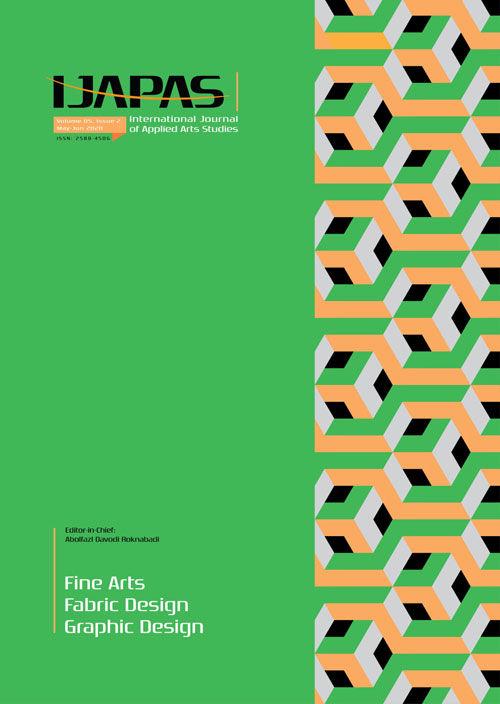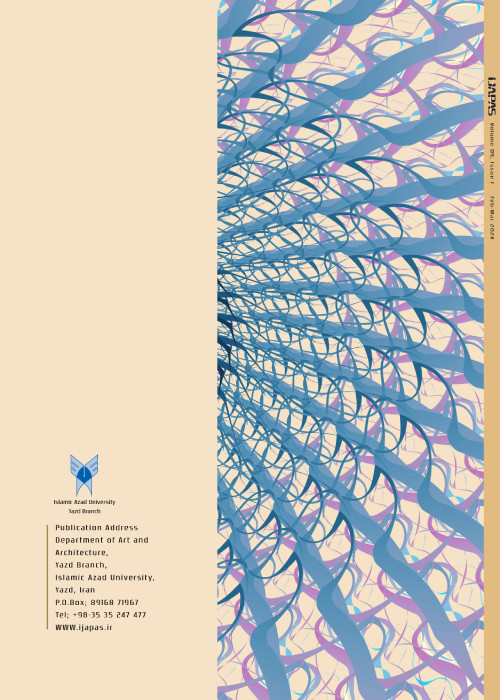فهرست مطالب

International Journal of Applied Arts Studies
Volume:5 Issue: 2, May-Jun 2020
- تاریخ انتشار: 1399/09/13
- تعداد عناوین: 6
-
Pages 7-28
Aesthetics term has been used for the first time by philosopher Alexander Baumgarten in 18thcentury which is referred to cognition through senses and sensory sciences. Although Mediaeval philosophic thought in west ignorance has been established based on Rome and Greek philosophy and has been formed by Christianity and has deep association with it, it is necessary to access to Old Testament books and ancient philosophers’ thought to investigate aesthetics, so in order to achieve this goal scholars’ views in different books have been used in this study. The present study extracts and verifies various aesthetic markers in the works of pseudo Dionysus and uses mixed qualitative and quantitative methods. Snowball sampling method employed to select scholars for interview and quantitative method conducted by Morgan Table. Books have been selected purposefully to extract elements, ATLASTI software applied to extract diagram in qualitative method and SPSS software also employed in quantitative method to do the related calculations. Results showed that 34 markers are extracted including light, proportion, being bright, absence of excess and...which in qualitative results ultra-beauty, coma, the best beneficence and... are the most repeated ones, but in quantitative sources integrity, creativity, ultra-beauty, absence of excess, harmonious, perfection, source and destination of everything and light have the most proportion.
Keywords: Aesthetic Elements, Dionysus, Mixed Method, Old Testament Books -
Pages 29-40
This work presents an important investigation of design basics and the golden proportional model in Persian painted pottery motifs (late fifth-early fourth millennium B.C.) and presents a comparison among Persian, Egyptian and Grecian fundamental design basics. Generally, Persian, Egyptian and Grecian pottery motif designs have some similarities and dissimilarities in their design basics. It can be concluded that the employed elements are nearly the same for all the investigated civilizations. The techniques used to achieve the principles in Persian studied designs have been understood to be either design of Egyptian painted motif like or Grecian motif design like. The used golden proportional models were found to have distinctive variations for the different civilizations. Persian has a higher degree of diversity in golden proportional models compared resulting in more well performed/pleasant designs.
Keywords: Design Basics, Principles, Golden Proportion Model, Persia -
Pages 41-60
India is a land of rich historical, cultural and artistic background. Painting has long been popular in India, and pre-Islamic paintings of caves and paintings from pre-Islamic India show interest in the art of Portrait painting and painting. Paintings from ancient times have been reported from inside caves and stone walls And most of the historical information about the art of painting in India, is the remainingcaves in Ajanta Cave. Undoubtedly, cave paintings have influenced the evolution of painting in later periods and created a variety of styles and schools of painting in the Hindu period, which is one of the artistic masterpieces of its time. The purpose ofthis study is the art of painting in India, the formation of different styles of painting in pre-Islamic India, the subject of paintings and the position of women in paintings. This research method describes pre-Islamic painting in India and analyzes different styles of painting based on drawings. The results of the research show that painting has been considered in India from the beginning as cave paintings and murals, and various painting styles are influenced by cave paintings and arise from mystical, religious and moral issues. Every day and different issues were created using various designs and colors and the presence of elements of nature. From the beginning of women's painting in the caves, women's painting has been depicted in the form of numerous goddesses and in later periods by drawing goddesses, queens, princes and other women in Hindu painting styles.
Keywords: Indian Painting, Cave Paintings, Painting Styles, Pre-Islamic India -
Pages 61-86
In Bangladesh, where pre-industrial traditions are still active ‘folk arts or crafts’, but artisans belong to socially and economically marginalized households, as in the lowercaste system. Traditionally, they contribute their knowledge of local materials. Their visual and tactile connections to cultural identities and integrity among communities had been profound. Jamdani have been successful in acquiring a Geographical Indicator (GI) Certification but facing threat from the spurious garments production of nearby Narayanganj, the backbone of the country’s economy; RMG. Though, there is a large demand of Jamdani clothes and fabrics for their distinct style only in the fashion houses and boutique shops, they are falling behind for their low rate of production, low wedge earning and lack of skilled workers.
MethodThe methodology of study will follow an extensive sociological field survey and by explaining proper number of cases,their need and opportunities found in reality and compare it with the facts inscribed in literature review of previous scholars. Possible
findingsThis study will focus and derive some propositions for community development and suggest some solutions: introduce automatic or semi-automatic loom, provide training to the weavers and ease the institutional marketing policy. Therefore, an incorporated Jamdani handloom development to implement handloom marketing-documentation is needed to engage with local communities for developing creative solutions and sustainability in local economies. Tangible and intangible resources must be addressed holistically, treated with due respect and carefully unveiled as cultural assets to prevent its extinction.
Keywords: Jamdani, Geographical Indicator Product, Cultural Heritage, Dhaka Region, Community Development -
Pages 87-98
The contemporary world is a space full of messages, and information that is exchanged constantly. All the urban visual effects (whether in open spaces or huge images, or in closed public places), have a special visual expression power that defines how they can be used in the field of environmental graphic design.Large and tourist cities face many problems. Problems related to tourist may arise in communicating tour guide such as the weakness of the information system in identifying tourist sites, the lack ofadequate facilities on sites such as maps, movies and educational boards. In tourist cities, one observes that environmentally graphic elements is not used and have no vitality and designed related to the urban texture. The present study, attempts to design and present a model based on informative environmental graphics to determine the specific route of tourism in order to know the space of urban tourism sites. Considering that the purpose of this research is to use the capabilities and functions of environmental graphics in the historical space of tourist cities and finally to provide a model to determine the routing infographic, so in terms of purpose it is practical -development. When studies done related to the scientific principles of environmental graphic design with aesthetic language as an effective tool in facilitating the routing of tourists and paying attention to special tourist routes, it is also based on descriptive-analytical research method. The environmental graphics at Naghsh-e Jahan Square do not respond to the rapid growth and development of this tourist site. This is because in many cases not only it does not convey information to the audience, but causes confusion and difficulty. Most of the environmental graphic factors in Naghsh Jahan Square are not in their proper place and therefore have lost their features and have only made this space more crowded. Therefore, with the proposed model of this research, domestic and foreign audiences can become more familiar and use the facilities and attractions of tourist sites.
Keywords: Environmental Graphics, Routing, Infographics, Tourism -
Pages 99-113
Structural similarities and differences in the visual expression of two artistic methods, i.e., tea house painting and comic strip art as new and emerging branches in the contemporary world are very significant. Comic is the art of narrating themes via images. Comic strips are parts of history, momentary memories and without an extensive burden of semantics that helps the reader's or viewer's imagination to go through in the desired directions. It is actually an art that highlightsthe story and executes it according to its own taste with sounds, whistling and self-made sound effects. Folklore or tea house paintings are parts of peoples' culture which contain the affection of people. This school has been established in tea houses, which is a meeting place for the poor and middle class, and has gradually become popular. It is not very clear when the first tea houses were established in Iran, but they certainly existed during the reign of Shah Abbas Safavid. In these tea houses, all classes, public and official people, and sometimes the king himself, would attend. In the field of tea house painting, the beliefs and boundaries of iconography as well as religion and traditions are the main forms of the image. On the other hand, the illustrated story is analyzed separately with the topics in terms of lack of spiritual thinking and only by the functions of two areas in recognizing visual relationship for the audience and the society. This study performed a comparative study method by collecting information through library.
Keywords: Tea House Painting, Comics, Comic Strips, Audio Effects


